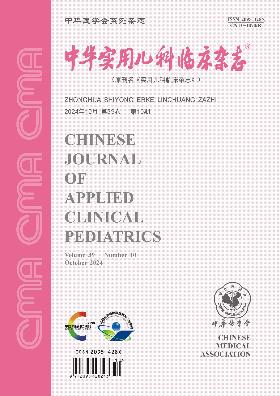Pathogenic copy number variation and clinical phenotype in children with neurodevelopment disorders
Q4 Medicine
引用次数: 0
Abstract
Objective To analyze the microdeletion and microduplication characteristics of pathogenic copy number variations (pCNVs) and clinical phenotypes in children with neurodevelopmental disorders, and to clarify the genetic pathogenic cause of children with neurodevelopmental disorders. Methods Children who were identified as neurodevelopment disorders such as global developmental delay and mental disorder, by next generation sequencing-based whole genomic copy number variation testing from January 2017 to November 2019 at the First Affiliated Hospital of Anhui Medical University were enrolled, and the clinical phenotypes and pCNVs were reviewed analyzed. Results There were 36 pCNVs in total 31 children, consisting of 24 microdeletion segments (66.67%)and 12 microduplication segments (33.33%), with sizes ranging from 320.00 kb to 93.26 Mb (mean 11.33 Mb). pCNVs frequently occurred in chromosome 15 , chromosome 8 and chromosome X, there were 9 children with 9 pCNVs in chromosome 15(25.00%), 3 children with 5 pCNVs in chromosome 8(13.89%)and 3 children with 4 pCNVs in chromosome X(11.11%) .The mainly clinical manifestations were motor disorder (30 children, 96.77%), mental disorder (22 children, 70.97%), speech development delay(22 children, 70.97% )accompanied by the malformation(11 children, 35.48%), abnormal face(11 children, 35.48%) and epilepsy(8 children, 25.81%), multisystem abnormalities generally exist in one individual. Conclusion This study demonstrates the clinical utility of whole genome CNVs testing in the genetic diagnosis of children with neurodevelopment disorders.Genetic pathogenesis of children with neurodevelopmental disorders can be revealed by the analysis of pCNVs. Key words: Neurodevelopmental disorder; Pathogenic copy number variation; Child神经发育障碍患儿的致病拷贝数变异和临床表型
目的分析神经发育障碍患儿致病拷贝数变异(pCNVs)和临床表型的微缺失和微重复特征,阐明神经发育障碍儿童的遗传致病原因。方法对2017年1月至2019年11月在安徽医科大学附属第一医院通过基于下一代测序的全基因组拷贝数变异检测确定为全局发育迟缓、精神障碍等神经发育障碍的儿童进行研究,并对其临床表型和pCNVs进行回顾性分析。结果31名儿童共有36个pCNV,包括24个微缺失片段(66.67%)和12个微重复片段(33.33%),大小从320.00kb到93.26Mb(平均11.33Mb)不等。pCNVs多发于15号染色体、8号染色体和X号染色体,其中15号染色体9例(25.00%),8号染色体5例(13.89%),X号染色体4例(11.11%),言语发育迟缓(22名儿童,70.97%)伴有畸形(11名儿童,35.48%)、面部异常(11名孩子,35.4.8%)和癫痫(8名孩子,25.81%),多系统异常通常存在于一个个体中。结论本研究证明了全基因组CNVs检测在神经发育障碍儿童遗传诊断中的临床实用性。pCNVs分析可以揭示神经发育障碍儿童的遗传发病机制。关键词:神经发育障碍;病原拷贝数变异;儿童
本文章由计算机程序翻译,如有差异,请以英文原文为准。
求助全文
约1分钟内获得全文
求助全文
来源期刊

中华实用儿科临床杂志
Medicine-Pediatrics, Perinatology and Child Health
CiteScore
0.60
自引率
0.00%
发文量
14243
期刊介绍:
Chinese Journal of Applied Clinical Pediatrics ( semi-monthly ) is a core journal of paediatrics under the supervision of China Association for Science and Technology, sponsored by Chinese Medical Association and undertaken by Xinxiang Medical College. Founded in 1986, it is openly circulated both at home and abroad. The journal has several columns, such as Expert Forum, Experimental Research and Paediatric Surgery, which are mainly for paediatric medical workers and medical researchers in hospitals. Its purpose is to reflect the new theories and technologies in paediatric medicine and scientific research at home and abroad, and to promote academic exchanges.
Chinese Journal of Applied Clinical Pediatrics is a source journal of China Science Citation Database (CSCD), a core journal of Peking University, a source journal of Chinese science and technology paper statistics (China Science and Technology Core Journals), a core academic journal of RCCSE, a high-quality scientific and technical journal of China, a high-quality scientific and technical journal of China Association for Science and Technology, and a high-quality scientific and technical journal of China Biomedical Science and Technology Association. We have been published in China Biomedical Literature Database (SinoMed), China Knowledge Network, Wanfang Data Knowledge Service Platform, China Academic Journal Abstracts, Scopus Database, Chemical Abstracts (USA), Japan Science and Technology Agency (JSTA) Database, Copernicus Abstracts (Poland), Abstracts of the Centre for Agricultural and Biological Sciences (CABS) of the United Kingdom, Cambridge Scientific Abstracts ProQuest Database, WHO Medical Journal of the Western Pacific Region (WMPR), and WHO Medical Journal of the Western Pacific Region (WMPR) of the United States. We have been included in dozens of authoritative databases at home and abroad, such as WHO Western Pacific Region Index of Medicine (WPRIM), Ullrich's Guide to Periodicals, and so on.
 求助内容:
求助内容: 应助结果提醒方式:
应助结果提醒方式:


